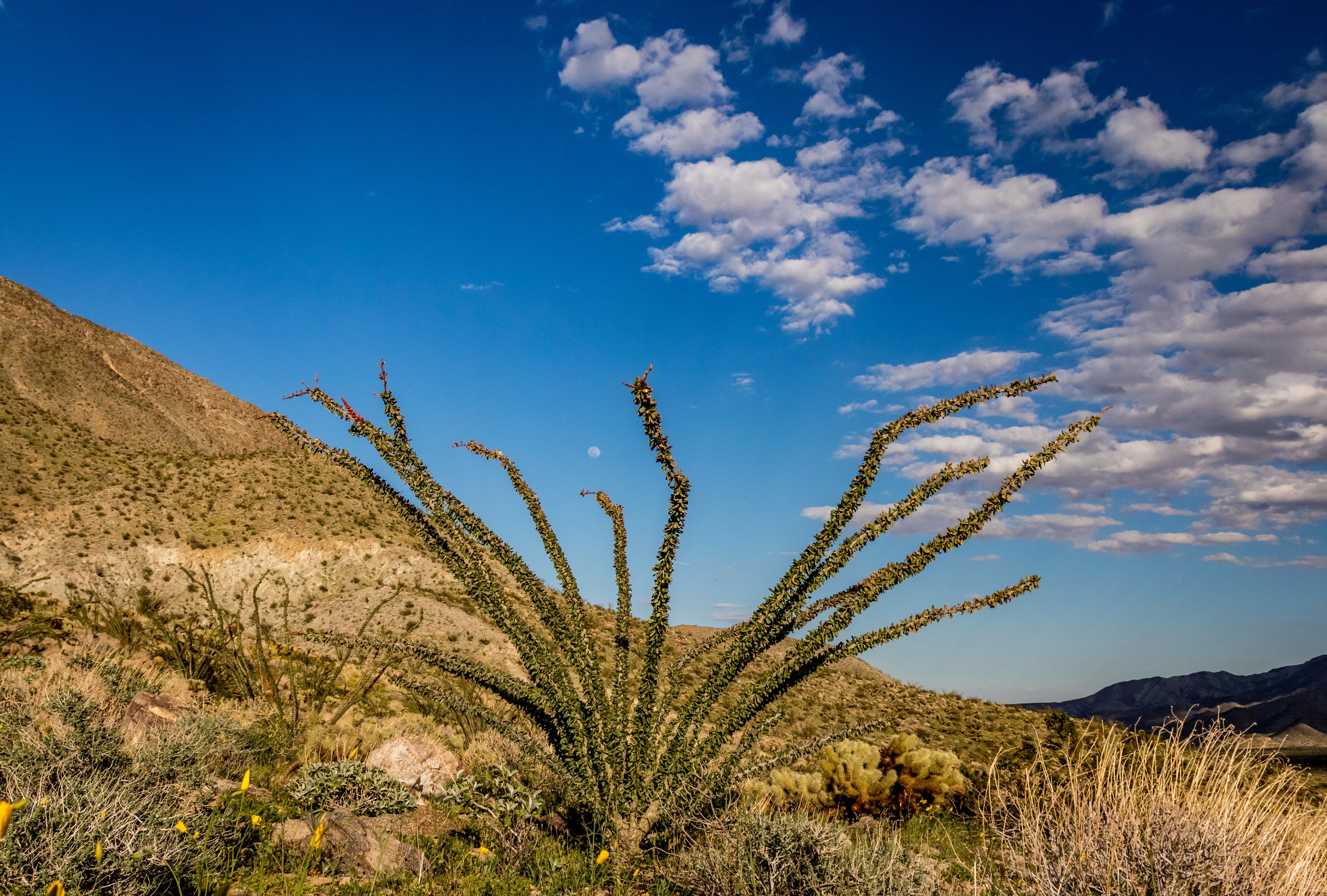Anza Borrego Desert State Park
Anza-Borrego Desert State Park encompasses some of the most diverse desert landscape in the world. Covering more than 600,000 acres, Anza-Borrego's wonders unfold from the eastern slopes of the Peninsular Ranges in San Diego County to the western edge of Imperial County. From Riverside County in the north, the Park reaches south almost to the Mexican border. Nearly two-thirds of the Park is pristine wilderness, sheltering an astonishing proliferation of plant and animal life, including the endangered Peninsular bighorn sheep.





Desert Garden
A desert garden just outside the Visitor Center building provides a quick look at some of the vegetation typical of the 600,000-acre park, with the species identified. There are more wonders in this desert than anyone could see in a lifetime, including wildflowers, which usually start blooming in force in late February or early March. Varieties of cactus bloom at all elevations but at different times, and for wildflower buffs they are the real prize. They tend to be "specimen" blossoms in colors ranging from red to yellow, and green. Other plants, such as the red chuparosa and the yellow brittlebush, show themselves as a mass of tiny flowers covering the surface of a shrub, or even a field of shrubs, or, in a good year, a broad expanse of pink sand verbena. It is often impossible to predict how desert plants will respond to the timing and amounts of rainfall and the fluctuations of temperature.





























Cactus Loop Trail
Broadly speaking, the desert is where you go to find cacti. Speaking specifically, Cactus Loop Trail is where you go in Anza-Borrego Desert State Park to see lots of cacti. True you can spot these prickly plants throughout the park, but this self-guided nature trail explores a rocky ridge that is utterly blanketed with a variety of cacti. A state park provided trail guide pamphlet offers a crash course in the area’s unique plants on this 0.75-mile loop with 225 feet of elevation gain.
Pick up a nature trail guide at the well-marked trailhead just across from Tamarisk Grove Campgrounds on Yaqui Pass Road south of Borrego Springs. Start hiking up a rocky ravine, where you will quickly pass the first of fourteen numbered markers along the trail that correspond with short entries in the trail guide pamphlet.
The first marker is next to chuparosa, a bush with red tubular flowers that are popular with humming birds. Along the trail you will also pass ocotillo, cholla cacti, beavertail cacti, and other desert plants described in the guide.





























The Slot
Simply named The Slot, this narrow siltstone canyon provides one of the most exciting hikes in Anza-Borrego Desert State Park. This 0.8-mike trek is capped off with a passage beneath a gravity-defying rock span. This short hike has just 100 feet of elevation loss, but the memory will be much more profound.
The Slot lacks a defined trail marker. From the parking area, look for footprints leading down into the ravine below. Left of the trailhead, just to the right of a dirt road continuing east, is a wide path that appears to descend into the canyon. This is not the way. The winding trail cliffs out above a dry falls in a side canyon above The Slot. The correct route is the narrow steep-looking track that drops right off the rim of the ravine, straight ahead from the parking area.
Slowly descend into the trench. The trail is steep, but not nearly as steep as it looks from above, dropping less than fifty feet. There are no more optical illusions from here, just eye-popping natural wonders.
Turn left and venture down to The Slot. The siltstone walls grow taller and closer together. A tenth of a mile from the start, the canyon becomes quite narrow. Hopefully you did not eat a big breakfast, because you will need to squeeze through course walls that are shoulder width apart, and less in places.
The shaded slot provides cool relief from the desert above. Progress through the narrows for 0.3 miles to the highlight of the trek, a slanted rock slab bridging a narrow gap in the canyon. This scepter-shaped block appears to have broken off one wall and come to a comfortable resting place between the two. The precarious feature could fall at any moment, but it remains lodged overhead, trapped in some loophole of the earth’s gravitational pull.




















